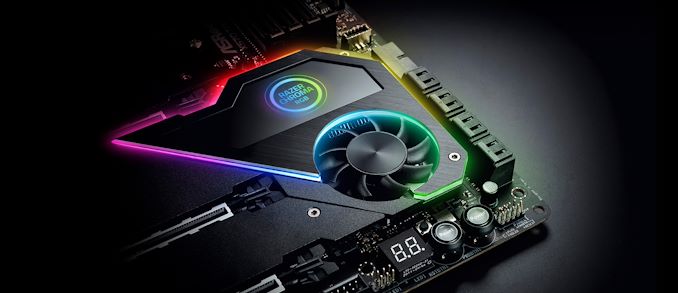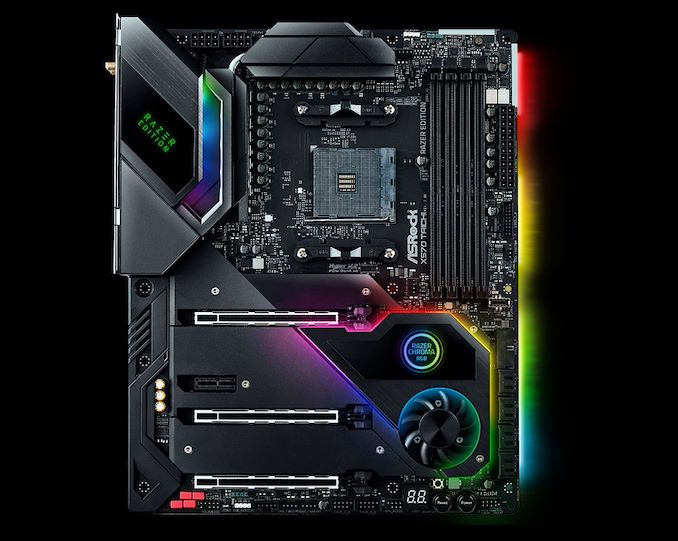ASRock x Razer: New Razer Taichi Edition X570 and B550 AMD Motherboards
by Gavin Bonshor on November 30, 2020 3:00 PM EST
ASRock and Razer have today announced a product collaboration. Two of ASRock's premium models for AM4 are being updated with Razer styling and Razer Chroma connectivity: the X570 and B550 Taichi Razer Edition. Built upon the popular Taichi series, both of the new Razer Edition variants include a 16-phase power delivery, with official support and compatibility with Razer's Chroma RGB ecosystem.
Whenever Razer does a collaboration with any company in the hardware industry, it gets people excited and talking. One of the most prominent brands globally with its green inspired peripheral range, as well as its various wacky ideas such as an RGB gaming toaster; I can't ever be as excited for a toaster as much as the Chroma Edition.

The ASRock X570 Taichi Razer Edition Motherboard
Back to the actual hardware, and it has teamed up with ASRock, a company seemingly fearless when trying new and off-the-wall ideas. This has realised the two new models, the B550 and X570 Taichi Razer Edition. The Taichi series is one of ASRock's most popular ranges, especially in the premium motherboard space, and the new Razer Editions will build upon this with both the AMD AM4 500 series chipsets being treated to some Chroma.
Both the ASRock X570 and B550 Taichi Razer Edition models will feature much of the same feature set including a large 16-phase VRM, built with premium 60 A chokes and Nichicon 12K black capacitors. In regards to the actual specifications, both of these new models correspond nearly identically with its non Chroma counterparts. The X570 Taichi Razer edition includes three PCIe 4.0 x4 M.2 slots, eight SATA ports from the chipset, a 2.5 GbE port as well as a Killer AX1650 Wi-Fi 6 module. For the B550, it is slightly lower down the pecking order due to the PCIe 4.0 support coming only from the CPU. It includes one PCIe 4.0 x4 M.2 slot, with an additional PCIe 3.0 x4 M.2 slot with eight SATA ports, four from the chipset and four from an ASMedia SATA controller.
The biggest impact and only differences between the standard X570 and B550 Taichi's compared to the Razer Edition models comes visually, with Razer's flair located around the board itself. The addition of addressable RGB headers taps into one of the biggest RGB Ecosystems around, the Razer Chroma RGB. On both models, the Razer logo can be found on the rear panel cover and the chipset heatsinks, for a bit of added flair and vibrance that RGB offers. These aren't OLED screens, just Razer branded vanity plates.
It should be noted that Razer is famous (infamous?) for doing things like green USB ports to unify the branding. That hasn't happened here however, indicating that this is more of a collaborative branding exercise rather co-design effort.
As it stands, the ASRock X570 and B550 Taichi Razer Editions aren't on the open market and neither company has opted to announce a release date or pricing. Given that both models include official pages (X570 and B550) on the ASRock website means that this launch for its target markets (TBA) should be imminent.
Related Reading
Source: ASRock








_thumb.jpg)













30 Comments
View All Comments
MadAd - Monday, November 30, 2020 - link
It still saddens my heart that over 20 years later the main PC industry still makes out that this outsized outdated form format which must only be fully populated by an absolute outlier user is what we all must need and floods the market with them to the point that to deviate means a lot of research and hand picking of parts to make something more suited to a PC of the 2020s.All it takes is for one major like AMD or Intel to make a stand and retire the format so each generation ATX releases work out to the same numbers as we see ITX releases now and expand micro and ITX to be the mainstream and they could revitalise the industry overnight.
Till then I guess we will carry on seeing grotesquely over designed over engineered product reinvented year after year. I wonder what happened to that unbridled drive for innovation that made this industry?
quorm - Monday, November 30, 2020 - link
I don't know, I've built several micro-atx systems in the past 20 years, but it seems like the least relevant form factor now. Personally, I like regular ATX for desktops, since the extra slots and space is sometimes useful, and it can still fit under a desk. Mini ITX has a clear place for compact builds, and it looks like there are at least 10 mini ITX x570 or b550 mobos for sale. Not sure what else you want to see in the relatively small market for enthusiasts who build their own pc.OMGWhyMe - Monday, November 30, 2020 - link
ITX has a real problem with getting multiple m.2 pcie slots, if not even one m.2 pcie slot.Only micro atx makes any sense.
quorm - Monday, November 30, 2020 - link
Well, the majority of x570 and b550 itx boards have 2 m.2 slots. Not sure what you're referring to.Why does micro atx make more sense? When would you choose it vs. regular atx, when your budget is constrained?
OMGWhyMe - Monday, November 30, 2020 - link
Yes, and those boards cost basically around $200+ for the ones that are 2 m.2 slots.For that kind of money, you might as well buy an ATX.
What I'm referring to is finding several decent budget ITXs that includes at least 1 m.2 pcie slot for a particular socket.
You might be able to find one or two for ITX but ATX and micro ATX there are pretty much 20-30+ different models that are available for each size that have at least 1 m.2
The reason why the micro ATX makes more sense is that they are cheaper if not the same cost as a full size ATX, even for the same chipset, they have four memory slots vs 2, they also come with one pciex1 slot and they are still significantly smaller than a full-sized ATX.
To really justify a mini ITX and the price premium they command you have to be using a really small case, also known as a mini-tower, if you are just using a mid-tower or a full-size tower it just doesn't make sense to purchase an ITX board.
quorm - Monday, November 30, 2020 - link
Yes, the only reason to get micro atx over regular atx is cost, but not many enthusiast builders are that cost constrained.OMGWhyMe - Tuesday, December 1, 2020 - link
Yeah, kind of the point, if you are buying something smaller with fewer slots it should not cost as much as a full-size ATX. Mini-ITX is just too expensive for what you get.Count Rushmore - Monday, November 30, 2020 - link
I agree on M-ATX makes more sense now. Traditional ATX casings are getting more compact which forced many PC DIYers to mount their AIO in front of the case. IMHO that's not ideal, since the best place to mount AIO is at the top of the case. M-ATX m/b will gives that extra clearance needed to mount the AIO at the top of the case.Adi6293 - Monday, November 30, 2020 - link
The best place to put the aio is in the front if you have an air flow oriented case, if the airflow is restricted then you put it in the top of the caseCount Rushmore - Tuesday, December 1, 2020 - link
Steve from Gamer Nexus covered about this in 1 of his video. Yes you get a few degrees lower temp IF you orient your AIO correctly in front of the case... BUT top mounting is the best for AIO longivity & to avoid pump noise (whgine).